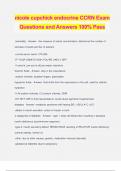nicole cupchick endocrine CCRN Exam Questions a nd Answers 100 % Pass osmolality - Answer - -the measure of solute concentration, defined as the number of osmoles of solute per liter of solution -normal serum osmo: 275 -295 -IF YOUR OSMO'S HIGH YOU'RE LIKELY DRY -if osmo's Low you're diLute (water retention) Isotonic fluids - Answer - stay in the vasculature -sodium chloride, lactated ringers, plasmalyte hypotonic fluids - Answer - fluid shifts from the vasculature to the cell - used for cellular hydration -0.45 sodium chloride, 0.2 sodium chloride, D5W -DO NOT USE to fluid resuscitate pt, could cause significant hypertension diabetes - Answer - metabolic syndrome with fasting BG >126 & A1C >6.5 -defect in insulin secretion, action of insulin or both 4 categories of diabetes - Answer - -type 1: beta cell destruction resulting in absolute insulin deficiency (autoimmune response) -type 2: insulin secretory defect; RESISTANCE resulting in RELATIVE insulin deficiency (central obesity, family hx) -other: due to other causes; genetic, medication induced (steroids) -gestational diabetes (due to pregnancy hypertonic solution - Answer - pulls fluid from the cell into the vasculature -D5 0.2 NS, D5 1/2 NS, D5 LR, Dextrose 10%, 2% Saline, 3% Saline, 5% Saline, 23.4% Saline -should be administered via central line -ex pt: cerebral HgbA1C - Answer - -estimates the effectiveness of diabetes therapy, average glucose over 3 month period of time -normal value 4 -5.6% (non -diabetic) -6-7%: average glucose range 100 -150 ->7%: indicative of poorly controlled glucose levels metabolic syndrome - Answer - -estimated 25% of the US population -40% incidence age >60 -high risk for developing CV disease and stroke "THE DEADLY QUARTET" 1) Dyslipidemia -Elevated triglycerides >150 -Low HDL <40 in males, <50 in females 2) Hypertension -Elevated BP: SBP>130 or DBP >85 3) Hyperglycemia -Fasting BG >100 or diagnosed T2DM 4) Abdominal obesity -Waistline >40 in men, >35 in women alpha & beta cells of the pancreas - Answer - -alpha cells produce glucagon (raises pt's glucose to prevent hypoglycemia) -beta cells produce insulin -delta cells produce somatostatin (inhibits release of glucagon & insulin) action of insulin - Answer - drives glucose, water & potassium into cells -regular insulin (IV) onset of action: 5 -10 mins mealtime fast acting insulin: -humalog (lispro), novolog SQ onset: 5 -15 mins. peak 1 -3 hrs, effects last 4 -6 hrs. rapid acting -regular insulin SQ onset of action: 30 mins. peak 1 -3 hrs, effects last 6 -8 hrs. short acting -NPH intermediate acting onset 1.5 -4 hrs, peak 4 -12 hrs, duration up to 24 hrs -lantus long -acting: inset 0.8 -4 hrs, minimal peak, up to 24 hr duration hypoglycemia causes - Answer - too much insulin, N/V, interrupted nutrition (oral, TF, or parenteral), strenuous exercise or stress, excessive ETOH, adrenal insufficiency, severe liver disease, pregnancy hypoglycemia symptoms - Answer - usually when BG <50 -70 or big shifts in glucose -CV (initial symptoms - activation of sympathetic nervous system): palpitations, tachycardia, diaphoresis, pallor, cool skin, piloerection, irritability -neuro: blurred vision, slurred speech, headache, difficulty concentrating, confusion, fatigue, weakness, diplopia, anxiety, tremors, staggering gate, seizure, coma




